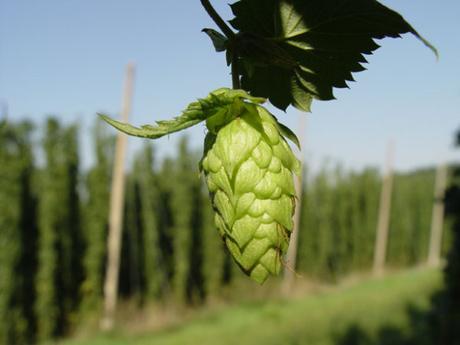
A follow up to yesterday's look at hop planting trends and the beers that influence them, since 1,000 words is certainly enough for one post...
Obviously, one of the biggest topics related to the use of agricultural goods can be cost. That's certainly not lost on hops, which has a wide range of pricing dependent on supply and demand.
Aroma hops are hot right now, so it's a natural assumption varieties in that category would cost more.
As the Brewers Association's Bart Watson noted in this piece, aroma vs. alpha hop prices move in opposite directions at the moment, partially because "Germany continues to be the lower cost alpha provider to the world, so U.S. aroma acres keep marching upward."
Watson mentioned that spot market prices may have little relation to contracted prices, but for posterity's sake, here are the lowest prices I could find on the Lupulin Exchange for hops they had available and I recognized as popular aroma/flavor additions, so note that these may not necessarily reflect the highest or even other prices:
On the other end, here are popular bittering hops (I realize Columbus can also be used for aroma) but with their highest listed prices, so note that current costs can easily be found for less:
This is not meant to act as some end-all example, but rather a pretty basic one to broadly show where prices stand through one avenue. I did find it funny that a year-old crop of Amarillo priced out the highest.
There may be fewer people more qualified to comment on the topic of hops than beer writer Stan Hieronymus, who, among many other books and articles, wrote " For the Love of Hops: The Practical Guide to Aroma, Bitterness and the Culture of Hops."
I emailed Stan to pick his brain about changes in hop farming and he shared some insight that offers great context for the trends I wrote about yesterday. Most notably, that popular varieties like Citra, Simcoe and Mosiac are currently controlled by Select Botanicals, an integrated botanicals management group that specializes in breeding new hop varieties.
"They are being very careful about expansion - making sure the hops are going in places they will grow, that they are consistent, that they are processed properly, etc.," he wrote, pointing to this page that touches on Select Botanicals' quality management policies. "Mosaic and Citra, and you will see it with Equinox, are picking up steam because now they have the rootstock to start to meet demand. I think almost any farmer offered an opportunity to plant those hops would."
Stan also mentioned that rights to rising varieties like El Dorado and Amarillo are held by individual farmers, but growers outside the Pacific Northwest are interested in trying their hand with those brands.
If you have access for Zymurgy's e-magazine, I highly recommend reading two of Stan's recent pieces:
- From the Jan/Feb 2014 issue, where he touches on new varieties and sharing growing rights.
- From the March/April 2015 issue, which discusses the process of brewers experimenting with new varieties. I found this one particularly useful in relation to my own post, given it highlights the need for increased hop acreage in the U.S. - "as much as 50 percent within the next several years" to meet predicted craft beer production demand, he writes.
One of the most fascinating parts of all this is how farmers outside of today's biggest hop-growing states are addressing the need for the product. According to the Hop Growers of America report, total hop growth outside the Pacific Northwest increased nearly 42 percent from 2014 to year-to-date 2015. Of course, the non-PNW crop still accounts for less than 3 percent of the U.S. harvest.
The report relies on a variety of help and reporting from experts around the country, so while these figures might not be perfect, there were several states with their first showing on the list of hop acreage strung for harvest:
- Arizona: 1 acre
- Pennsylvania: 4 acres
- Iowa: 5 acres
- Maryland: 15 acres
Of particular interest to me was New York's growth, which went from 150 harvested acres in 2014 to 250 acres strung in 2015. As Brew York's Chris O'Leary pointed out last year, this will be a very important state to watch thanks to big tax incentives provided to New York breweries who use in-state products to make their beer.
According to the Cornell Cooperative Extension, an outreach system of Cornell University that focuses on agricultural research, these are the hops that would grow best in New York (categorization is their own):
- Aroma: Cascade, Willamette, Mt Hood, Fuggle, Liberty and Perle
- Alpha (bittering): Brewers Gold, Chinook, Centennial and Newport
With the exception of Centennial, this list simply emphasizes the importance of success for Pacific Northwest hop farmers, as brewers all over are seeking "it" aroma varieties not mentioned here, but discussed in my previous post.
Related: If You Drink It, They Will Grow: A Changing Landscape for Hops
Bryan Roth
"Don't drink to get drunk. Drink to enjoy life." - Jack Kerouac

